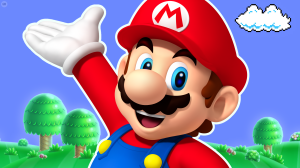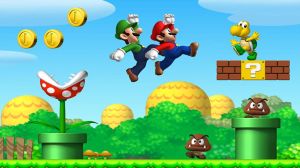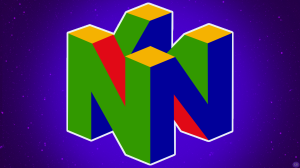
Nintendo began dabbling with open-world Super Mario games way back in 1996, when it brought Super Mario 64 to the forefront and showed the world just how a 3D platforming game should be done. Since that time, it’s become an instant classic that’s still enjoyed after two decades, but we’ve also seen Nintendo evolve the idea of what should go into such a platformer with its subsequent games.
Videos by ComicBook.com
Even though not all fans were crazy about it, Super Mario Sunshine followed this logic when it came out for the GameCube, creating some open-world exploration that revolved around Mario’s new gameplay techniques, namely with the FLUDD water-jet system.
But it’s with the release Super Mario Galaxy, a game that was released ten years ago to this day for the Nintendo Wii, that we really got to see what kind of growth we’d see out of the company’s 3D platforming design. Being able to “hop” around the galaxy with ease in the hopes of saving it from the dreaded Bowser, the game implemented some wonderful gameplay ideas based around the Wii Remote, while at the same time keeping Mario’s familiarity intact. As a result, it created a legacy that some fans still fondly look to – and might be able to recognize in Nintendo’s latest Mario triumph, Super Mario Odyssey.
Let’s look at some of the inspirations that came from this chapter in the series, as well as what followed with its wonderful sequel, Super Mario Galaxy 2.
Open World, Around the Planetoids

The neat thing about Super Mario Galaxy is how it created an open-world environment for something that was literally on a world, or in this case a planetoid. For instance, Mario can make his way around whole planets, finding little things like hidden coins, pipes that lead to the opposite side (possibly to reach something encased in an unbreakable container, like a coin or a Star), and finding enemies. It was a nice little design for a Mario game, and one that had us scouring each planet we were on, just in case we missed something.
This design was improved upon in Galaxy 2, with the introduction of a “home world” sort of vessel where Mario could check in with his guests, see what mail came his way, and maybe even scavenge for a secret here and there. While the Odyssey featured in Super Mario Odyssey isn’t as in-depth (you just sit inside it), we could definitely see some inspiration from it, especially with the way it hops around worlds – just like the old Mario ship did.
A Bigger Sense of Exploration

Super Mario Sunshine did a good job with its open worlds when it came to navigating towards Shines, or finding out-of-the-way secrets. But Mario Galaxy‘s worlds took it to a whole new level, between hopping around planetoids and finding your way through even larger worlds, ones filled with dangers and even more hidden secrets. It was a testament not only to the team behind the game, but also the Wii, as it showcased just what the hardware was capable of – even without the benefit of HDMI connection.
And it only got better with Galaxy 2, as levels became much larger and, in some cases, even more complex, especially the Challenge Stages, which lived up to their name. Just ask any veteran who was trying to make their way around by bouncing off walls without the benefit of a floor beneath them.
Odyssey has grown as well, possibly inspired by Galaxy‘s design. After all, there are wayyyyy more hidden things in each world you traverse through, And it almost feels like every level is in a “galaxy” in its own right. That said, there’s also a nod of the cap to the classic Super Mario 64 – especially with its underwater levels.
Gameplay That’s Out of This World

Mario’s ability to hop on enemies to bop them into oblivion is still intact in Super Mario Galaxy, but there’s a great new technique that makes it easier to attack enemies. It’s the spin technique, which can be performed with a simple set-up on the Wii remote. By doing this, Mario can knock enemies back long enough to finish them off once and for all – quite handy if he becomes surrounded.
On top of that, the abilities really introduced a number of ways that Mario could enhance his game, like the Boo Suit (enabling him to float in the air), the Spring Suit (which gives him greater jumping capabilities) and the Bee suit. We can kind of see variations of these in Odyssey, as Mario can possess a great deal of characters, taking over their abilities and techniques. He can also play dress-up in a number of ways – even a bridal dress.
It’s fairly easy to see comparisons between Galaxy and Odyssey when it comes to gameplay – even if they are two different pieces of hardware.
Evolution of Cooperative Play

Super Mario Galaxy was one of the first 3D platformers in the series that enabled two-player support – though not in the way you think. The first player takes control of Mario, while the second can point a reticule on the screen and fire “stars” at enemies, helping him finish them off a little more conveniently. While it’s not nearly as fun as having Luigi join Mario in a game, this did provide an interesting experience for families looking to get more involved with Mario games.
And that technique lives on today with Odyssey, as you can have two players take part in a session, with the first player controlling our hero and the second controlling Cappy independently, working alongside to defeat enemies. It’s a little more involved than what Galaxy had to offer, and you can see the team really wanted to push the idea of multiplayer forward, but not so much in the way that Super Mario 3D World did.
But, Odyssey is a different game than World, so it makes sense that it would focus primarily on Mario – but still with a little help from his friends.
So Where Does Galaxy Go From Here?

The Super Mario Galaxy legacy was short but sweet, with the original game selling more than 12 million copies, and the sequel clearing out over seven million copies. That said, have we seen the last of it?
Sure, Super Mario Odyssey just came out, and is already one of the Switch console’s biggest sellers with millions of units out the door, so Nintendo probably isn’t in a rush to get the not-so-plumber back in a new adventure. However, they have been thinking about it, and Super Mario Galaxy 3 would probably make the most sense when it comes to its next release (though New Super Mario Bros. wouldn’t be out of the question, either).
For now, players can enjoy Galaxy in all its glory on both the Wii and the Wii U, in case they feel like discovering it again. Of course, we also recommend Odyssey, because that’s the best Mario’s been in years. Whichever way you go, you’ll see the hero’s evolution in 3D platforming, like you never thought you would have. And that’s a great thing.





